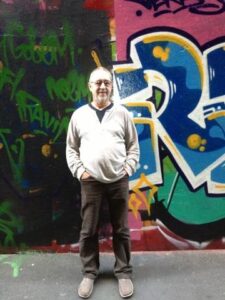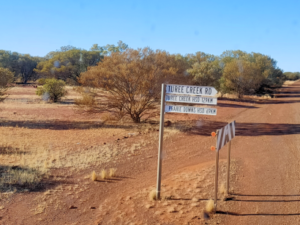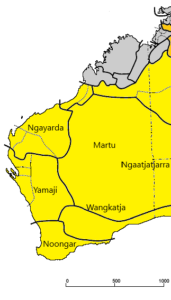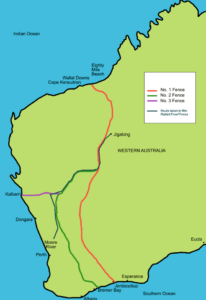by Bill Holloway
 It is hard to describe how desolate the country north and inland of Perth WA and the surrounding Wheatbelt is – just low scrub and desert for thousands of kilometres. But in the first half of the twentieth century it was the setting for a remarkable confluence of Independent Women.
It is hard to describe how desolate the country north and inland of Perth WA and the surrounding Wheatbelt is – just low scrub and desert for thousands of kilometres. But in the first half of the twentieth century it was the setting for a remarkable confluence of Independent Women.
In 1927 Katherine Susannah Prichard ventured north (from Perth) by train and truck to stay with “a friend whose husband owned a cattle station”. She wrote, “… so I travelled four hundred miles beyond the end of the railway to get the correct setting for that short story [The Cooboo]. There I found too the background for Coonardoo and Brumby Innes”. Ric Throssell, her son, adds, “With a four-year-old son in tow, she travelled to the end of the railway line at Meekatharra, and four hundred miles further on by truck, to Turee Station in the far north-west beyond the Ashburton River.” (KSP, Child of the Hurricane, 1964; Ric Throssell, Wild Weeds and Wind Flowers, 1975)
 The line they took, the Northern Railway, was used for passengers and freight from 1890 to 1970. It connected Geraldton on the west coast (430 km north of Perth) with the Murchison goldfields towns of Mt Magnet, Cue, Meekatharra and Wiluna. From Perth, travellers could access the line via the Midland Line from Guildford to Geraldton; or via the northern wheatbelt line from Northam, 100 km inland of Perth on the Kalgoorlie line, to Mullewa 100 km inland of Geraldton on the Northern Line. Later, KSP made the circuit, Perth, Geraldton, Mullewa and back, by train with Wirth’s CIrcus, to get material for Haxby’s Circus (1930).
The line they took, the Northern Railway, was used for passengers and freight from 1890 to 1970. It connected Geraldton on the west coast (430 km north of Perth) with the Murchison goldfields towns of Mt Magnet, Cue, Meekatharra and Wiluna. From Perth, travellers could access the line via the Midland Line from Guildford to Geraldton; or via the northern wheatbelt line from Northam, 100 km inland of Perth on the Kalgoorlie line, to Mullewa 100 km inland of Geraldton on the Northern Line. Later, KSP made the circuit, Perth, Geraldton, Mullewa and back, by train with Wirth’s CIrcus, to get material for Haxby’s Circus (1930).
The principal women of my ‘confluence’ are Prichard; Daisy Bates; Molly, Daisy and Gracie, the heroines of Follow the Rabbit-Proof Fence; and Ernestine Hill.
The region they all variously lived in or passed through is centred on present-day Newman (built commencing 1968 to service BHP’s iron ore mines), on the Tropic of Capricorn 1200 km north of Perth. These days Newman is the next town after Meekatharra on the Great Northern Highway and they are separated by 420 km of fairly bleak desert, gibber plains, acacia scrub and occasional ghost gum-lined creek crossings.
 So “four hundred miles” (640 km) from Meekatharra would have put KSP well north of Newman, north even of Roy Hill Station (120 km north of Newman) where Daisy Bates’ husband, Jack was an overseer in the late 1890s. But in fact Turee is south west of Newman, about 120 km, and so only 300 km, or less than 200 miles, north of Meekatharra.
So “four hundred miles” (640 km) from Meekatharra would have put KSP well north of Newman, north even of Roy Hill Station (120 km north of Newman) where Daisy Bates’ husband, Jack was an overseer in the late 1890s. But in fact Turee is south west of Newman, about 120 km, and so only 300 km, or less than 200 miles, north of Meekatharra.
I work in the North West and I sometimes wonder if Prichard actually went by train to the end of the wheatbelt line at Mullewa and then by Turee’s T-model Ford truck along the ‘Woolwagon Pathway’, the network of rough tracks servicing the stations of the Murchison. The distance would be (roughly) right and when she left Turee she went on to Onslow, a port town which marks the northern end of the Pathway.
In telling these stories, it is important to remember whose country this is. The ‘wheatbelt’ and south-west including Perth is Noongar country; further north is Yamaji, encompassing Geraldton, Carnarvon and inland, the Murchison and Gascoyne Rivers; Roebourne, the Ashburton and Fortescue Rivers is Ngayarda; inland is Martu, the northernmost of the Western Desert peoples whose country extends south and east to the Nullarbor in South Australia. An analysis of the Language in Coonardoo demonstrates that the Aboriginal people on Turee Creek must have been Martu.
 Daisy Bates, who had been some years in England, rejoined her husband Jack and 13 yo son, Arnold in Perth in 1899, planning to report back to the London Times on relations between outback pastoralists and their Aboriginal workers.
Daisy Bates, who had been some years in England, rejoined her husband Jack and 13 yo son, Arnold in Perth in 1899, planning to report back to the London Times on relations between outback pastoralists and their Aboriginal workers.
On her first trip north she travelled by buggy, through semi desert country entirely without roads, from the port at Cossack (1,500 km north of Perth) out to Roy Hill station, then to the 180,000 acre Ethel Creek station nearby, which she and Jack intended to buy, and back (past Turee Creek) to Carnarvon. A round trip taking, she wrote, six months and 800 miles, allowing plenty of time for her to begin what was to be her life’s work, recording Aboriginal language and customs.
On her next trip, she worked for some months at the Trappist ‘model’ farm for Aboriginal workers near Broome, before, as told in Three Thousand Miles in a Side-Saddle, purchasing 700 head of cattle, which with Jack and Arnold she drove 1,000 miles south to Roy Hill, where they stampeded to get to water. So many were lost that none could be retained to start a herd at Ethel Creek. Daisy left them there, and Jack and Arnold (again), hitching a ride back to Port Hedland, while the remaining cattle were taken on to “the railhead at Peak Hill”* for transport to Perth, where their sale just covered her costs.
Daisy worked for some years in Perth and southern WA, recording the dying languages of the Noongar. In 1910-11 she was persuaded to join the Cambridge University Expedition of A.R. Radcliffe-Brown studying Aboriginal language and culture at Sandstone (on a branch line east from Mt Magnet); and subsequently on the Dorre and Bernier Islands in Shark Bay out from Carnarvon where the government had made an ill fated and short lived attempt to isolate ‘diseased natives’.
By this time Daisy Bates was well known through her journalism and an experienced anthropologist but she didn’t get on with Radcliffe-Brown who treated her as an amateur and later stole her work. On parting from the Expedition, she wrote, “I turned my footsteps to the head of the Ashburton, Gascoyne, Murchison and Fortescue Rivers, once a great highway of aboriginal trafficking”. But what she meant by this I am not sure, as her next move was to Eucla on the WA/SA border.
 The story of Molly, Dasiy and Gracie has become well known from the book Follow the Rabbit-Proof Fence (1996) written by Doris Pilkington (Molly’s daughter) and the subsequent movie. The girls were Martu, who had begun basing themselves at Jigalong when a camp for workers on the rabbit-proof fence was set up there in 1907. Ethel Creek is (relatively) nearby, so it’s possible Daisy Bates studied their grandmothers.
The story of Molly, Dasiy and Gracie has become well known from the book Follow the Rabbit-Proof Fence (1996) written by Doris Pilkington (Molly’s daughter) and the subsequent movie. The girls were Martu, who had begun basing themselves at Jigalong when a camp for workers on the rabbit-proof fence was set up there in 1907. Ethel Creek is (relatively) nearby, so it’s possible Daisy Bates studied their grandmothers.
In 1931, the girls aged 8-10 years, were taken from Jigalong, from their mothers, by police based at Nullagine, by car, by train from Marble Bar to Port Hedland, and thence by coastal steamer to Perth. There was a reception centre for Aboriginal arrestees in East Perth, later known as Jack Davis House, and from there they were taken to the Moore River Settlement internment camp 120 km north.
Led by Molly, they almost immediately escaped, walking north and then east within the Wheatbelt, until they met up with the No.2 Fence which they followed to Meekatharra – where Gracie caught the train to join her mother in Wiluna – and so on home, hitching the last couple of hundred kilometres with a camel train.
Ernestine Hill (1899-1972) was a freelance journalist and single mother (her son, Robert’s, father was rumoured to be her boss at Smith’s Weekly, R.C Packer, Kerry Packer’s grandfather). The Great Australian Loneliness (1937) is her account of the journey she undertook (on her own while her mother cared for her son) around northern and central Australia in 1930-32 and the people she met.
She set out from Hamelin Pool on Shark Bay, south of Carnarvon, hitching lifts with station owners, mail trucks and coastal cargo vessels up the west coast. From Port Hedland she took the train to Marble Bar and there learnt the story of “Maudie and Nellie, the two little half-caste girls who … never having seen a map in their lives, ran away [from Moore River] … and found their way back across 1,500 miles of unknown desert” .
Hill continued on into the NT, getting a lift at one stage with Michael, father of Elizabeth and Mary Durack with whom she later became friends, then returned via Perth to South Australia to meet Daisy Bates, by then camped at Ooldea, and with whom she was to collaborate (unacknowledged) in the writing of The Passing of the Aborigines (1938). Finally, she headed back north via Coober Pedy and Hermannsburg, finishing her account riding a camel into Alice Springs.
After WWII, Hill purchased an army surplus 4WD truck which she used as a campervan. In 1947 she and poet Henrietta Drake Brockman drove it across the country from Perth, stopping in Kalgoorlie to see KS Prichard who was there researching her Goldfields trilogy. In Kayang and Me (2013) Noongar-Wirlomin woman Hazel Brown (writing with Kim Scott), reports having seen (presumably south of Kalgoorlie) two women in a strange vehicle on their way to meet Daisy Bates. I’m not sure the dates match, but … Hill later wrote a biography of Daisy Bates, Kabbarli, not published until 1973.
There are many other literary connections: Mary Durack’s Kings in Grass Castles (1959) which glosses over her family’s involvement in Aboriginal massacres, later documented in Every Mother’s Son is Guilty (2016) by Chris Owen; Neville Shute’s Beyond the Black Stump (1956) which is set on a station in the Murchison, up Turee Creek way; Riandolph Stow’s semi-autobiographical The Merry-go-round in the Sea (1965) which is set in Geraldton and on family properties out to Mt Magnet; Charmaine Papertalk Green & John Kinsella’s False Claims of Colonial Thieves (2018) reflecting their respective connections to the country around Mullewa.
The Fringe Dwellers (1961), our first novel featuring an Aboriginal family, is also set in Geraldton where author, Nene Gare was district nurse and her husband was in charge of State Housing. Alice Nannup, a Ngayarda woman, from a station near Roebourne, in her memoir When the Pelican Laughed (1992) tells of being taken from her mother to E. Perth and on to Moore River, and then being sent out as a servant. She worked for some time on stations out from Leonora, but eventually got permission from the Protector to marry and went to live in Geraldton, where she says she was friends with the Aboriginal woman helping Gare with her book.
Lizzie Marrkilyi Ellis (b. 1962), a Ngaatjatjarra woman,from the WA/NT border, went to school at the Baptist mission at Karalundi, north of Meekatharra where one of the housekeepers was Gracie of Rabbit-Proof Fence fame (Pictures from my Memory, 2016).
May Holman (1893-1939), Australia’s first female Labor parliamentarian, as a child lived in Cue, arriving there in 1905 when the train line had still only reached Yalgoo, east of Mullewa. Her father became the local member and was for a while Minister for Railways.
And then there’s Robyn Davidson, whose journey by camel which is the subject of Tracks (1980) appears to be a reverse image of Ernestine Hill’s, starting at Alice Springs, traversing central WA from east to west, and finishing at Shark Bay, seeking solitude in the desert where Hill sought ‘colour’.
* Ernestine Hill also mentions a railhead at Peak Hill (1937, p.59). Peak Hill was a gold mining town 120 kms north of Meekatharra (so halfway from Meeka to Turee Creek), but I can’t find any evidence the Northern Railway extended that far.
.
Photos by the author.
The Northern Railway east of Mullewa
The turnoff to Turee Creek on the Great Northern Hwy, south of Newman
Bill Holloway, the author of this essay, blogs at The Australian Legend. He is an old white guy the subject of whose (very) mature age M.Litt thesis was ‘The Independent Woman in Australian Literature’.







Great read! Thanks, Bill.
Thank you Jo. I love thinking about all these women criss-crossing the north west. Just in the past year I’ve been all the way along the Nullagine road, past Roy Hill, Nullagine and Marble Bar to Port Hedland; and also up the Ashburton road past Peak Hill to within 50 km of Turee Creek.
Thanks, Bill. I found this fascinating.
Thanks Jennifer. It’s a story I think about often as I’m driving around (You might be able to tell it started out years ago as a story about the Northern Railway).
There’s a lot of new information here; I’ll have to reread a few times to appreciate the interconnections. As usual, the photos are very helpful.
I’m aware when I’m writing about Western Australia, especially the north west, that most of my readers only have a very general idea about the relative locations of the places I am mentioning.